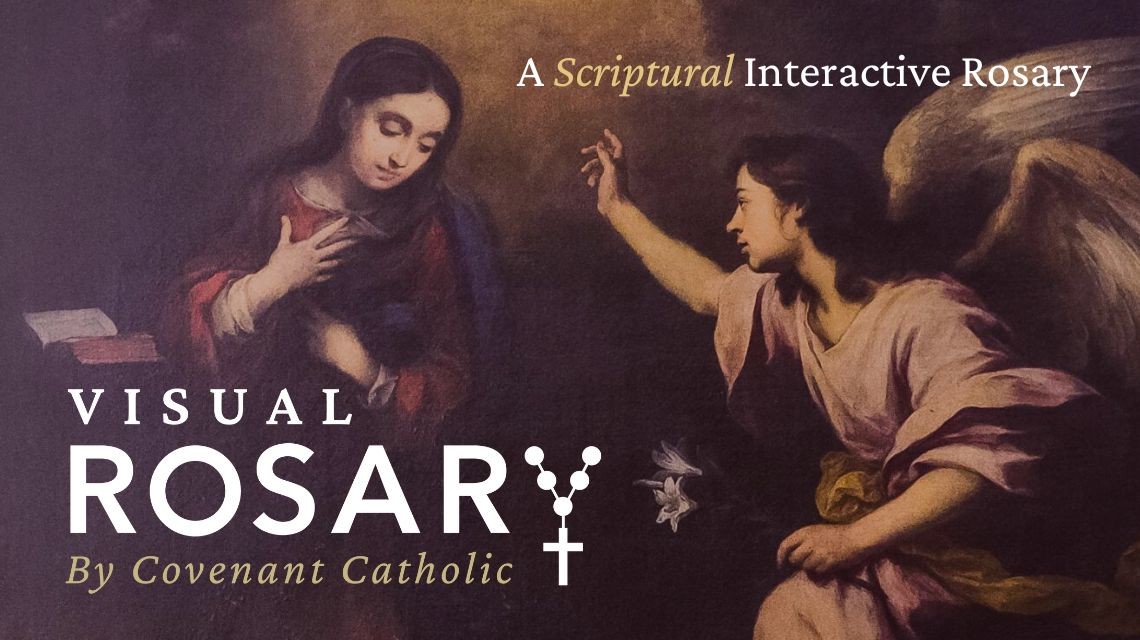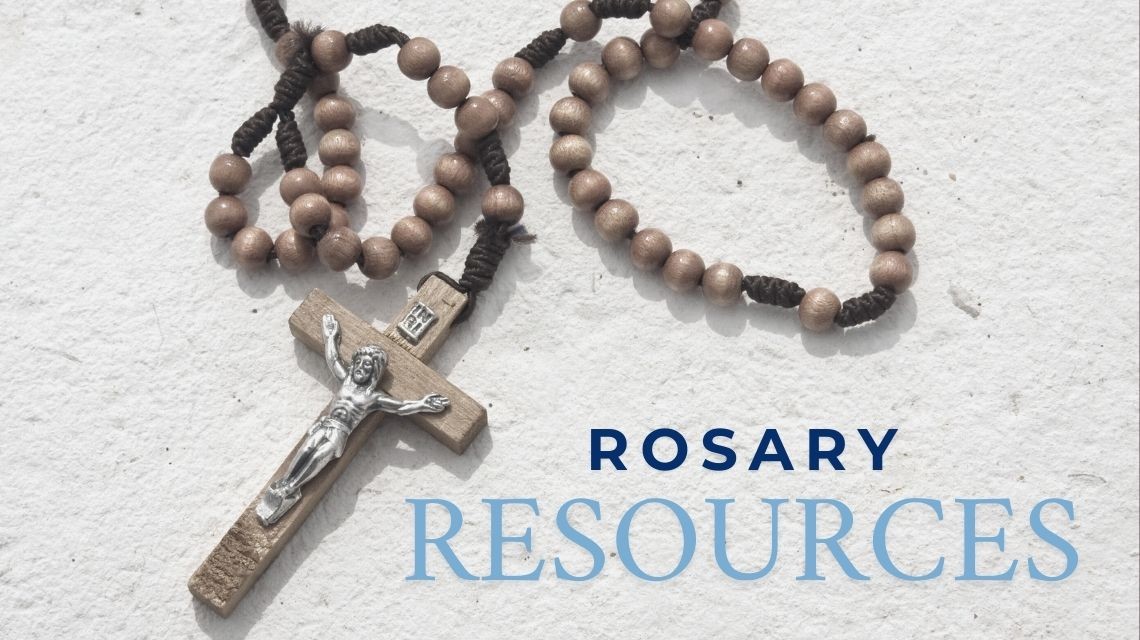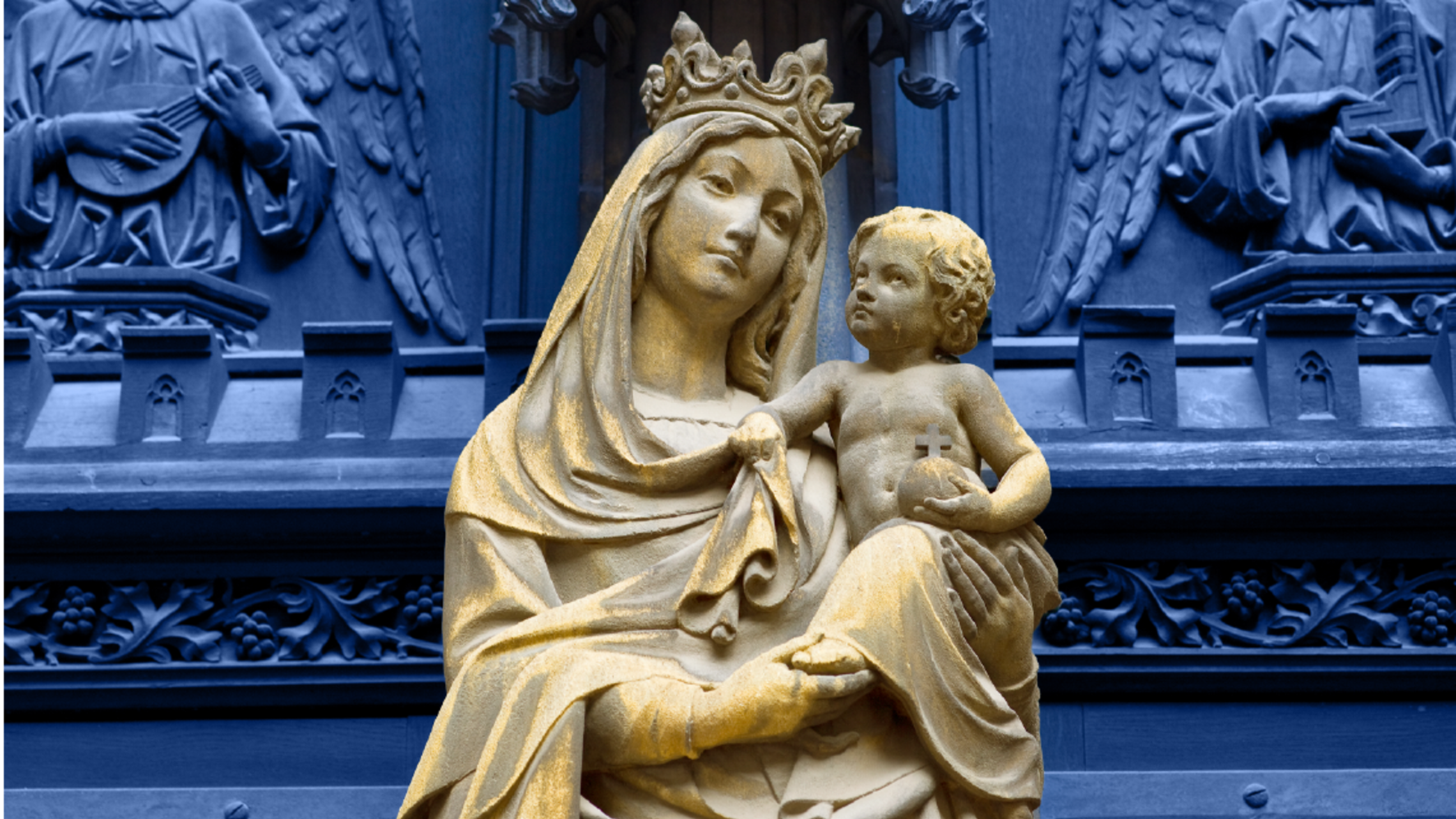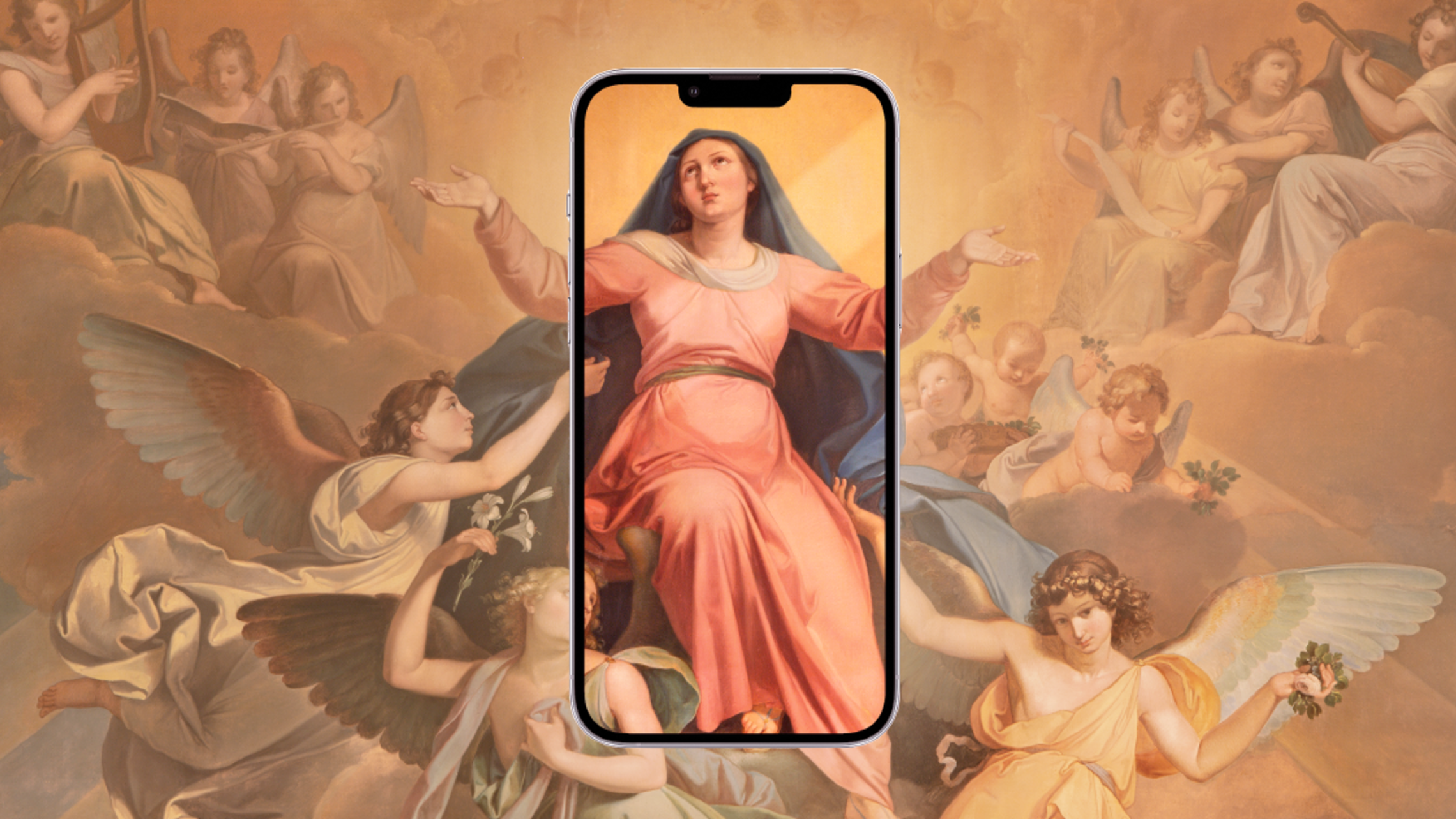Are you looking for a scriptural Rosary? Don't miss the Visual Rosary with scripture verses accompanying every Hail Mary!
What is a Scriptural Rosary?
Not to sound like a broken record, but once again I am going to touch on the topic of distraction while praying.
You see, when we are praying — whether the Rosary or something else — our thoughts are inevitably pulled away from our prayers and toward the other elements of our daily lives: work, study, scheduling, children…
I’m sure you can relate.
Last month, we talked about Holy Distractions as a means of refocusing our wandering minds back to our prayers. This month, we’ll see how the Scriptural Rosary — a method of praying the Rosary using Scripture readings — can help to bring our focus back to meditating on the Mysteries.
This meditation allows us to really dive into the lives and experiences of Mary and Jesus, and contemplate all they have done for our salvation. — rather than numbly or absentmindedly ticking off the prayers until we’ve completed five decades, only to realize that we were simply repeating the phrases rather than truly praying.
Finally, truly contemplating the Mysteries by discovering their Scriptural origins, keeps those passages at the front of our minds as we move through our daily lives, guiding our actions and our decisions along the way.
For the Scriptural Rosary, there are two prayer options:
The Beginner Option
Read a (longer) relevant passage from Scripture after announcing the Mystery, and before reciting the decade of Hail Marys.
The More Advanced Option
This option, for the less easily distracted, is where you read a brief (one-sentence) passage from Scripture before reciting each Hail Mary.
You can understand why this would not likely be an option for those who are attempting to pray the Rosary with small children, or during a walk around the parking lot at work, for example.
For our purposes, we're going to focus on the first option, just to get us started.
Below, I have summarized each mystery, and included the Scriptural passages for you to look up the readings.
If you’d like some more insightful details about each reading, I recommend Edward Sri’s The New Rosary in Scripture. This book includes wonderful historical insights into the Biblical details of each set of mysteries.
Joyful Mysteries
The Joyful Mysteries commence with an incredible event in the life of a young girl named Mary in the town of Nazareth. In the Annunciation, an angel of the Lord — Gabriel the Archangel — appears to Mary and announces that, upon her consent, she will become the mother of the Son of God!
In the Visitation, Mary and her cousin Elizabeth, also with a child and further along than Mary, share their joy and excitement with one another as Elizabeth’s unborn child recognizes that the child in Mary’s womb is none other than the Lord Himself.
The Nativity highlights Mary’s experience of childbirth under extremely impoverished conditions. We can share in the shepherds’ joy at their encounter with the infant Jesus and the angels’ elated singing: “Glory to God!”
The joy of the Presentation of Jesus in the Temple is tempered by a foreshadowing of Jesus’ future suffering and death. Simeon sings God’s praise even as he prophesies that the Child before him is destined to be a cause of division in Israel, and a sword piercing Mary’s own heart.
The final Joyful Mystery, the Finding of the Child Jesus in the Temple, reveals an anxious Mary and Joseph searching Jerusalem for Jesus, to finally discover Him questioning the elders in the Temple with wisdom beyond His years.
Here are the passages, for your reference:
- Annunciation - Luke 1:26-38
- Visitation - Luke 1:39-56
- Nativity - Luke 2:1-20
- Presentation - Luke 2:22-40
- Finding in the Temple - Luke 2:41-52
Luminous Mysteries
John the Baptist preaches forgiveness for those who confess their sins and repent. He baptizes them in the River Jordan. Then Jesus arrives, insisting that John baptize Him, too, as an act of solidarity with humankind. The Holy Spirit descends upon Jesus like a dove; the Lord delights in those upon whom the Holy Spirit comes to rest.
The Wedding at Cana highlights Mary’s mercy in times of distress. When a young couple runs out of wine at their own wedding feast, Mary turns to Jesus. Though He hasn’t yet performed a single miracle, Mary’s faith in His ability to help is unwavering. Through Mary’s own intervention, Jesus begins His public ministry by turning water into wine.
When we pray the third Mystery, the Proclamation of the Kingdom, our focus is on Jesus’ offer of mercy to sinners. But this offer demands a response on our part: conversion — “repent and believe the Gospel.” Jesus challenges the Pharisees to turn their focus from their man-made legal customs, to mercy and the forgiveness of sins.
The Transfiguration reveals Jesus in His full glory. He brings three of His closest apostles, Peter, James, and John, up the mountain with him, where they witness the Father’s voice calling out from the clouds that Jesus is His beloved Son, and that they are to listen to Him. We’re reminded, here, that we are also called to reflect God’s glory through our own loving actions.
At the Last Supper, Jesus calls his apostles to the Upper Room and offers them His body and blood — speaking in a way that identifies Himself as the Passover Lamb, who will be sacrificed for the redemption of humankind. In the Institution of the Eucharist, Jesus establishes Holy Communion as our very communion with Jesus Himself.
Here are the Scriptural passages:
- Baptism of Jesus - Matthew 3:1-17
- Wedding at Cana - John 2:1-12
- Proclamation of the Kingdom - Matthew 5:1-16
- The Transfiguration - Matthew 17:1-8
- The Institution of the Eucharist - Mark 14:22-26
Sorrowful Mysteries
Jesus suffers great Agony in the Garden as He is confronted by all of humanity’s sin and temptation. He resolves to do His Father’s will, but He realizes there is unbearable suffering ahead: betrayal, scourging, a crown of thorns, a cross to carry, and ultimately, crucifixion.
In the Scourging at the Pillar, we see Pontius Pilate caving in to the pressures of the crowd, as the Pharisees, in a fit of murderous jealousy, insight the crowd to demand Jesus’ crucifixion. In an attempt to clear his conscience, Pilate releases himself from the responsibility of Christ’s death — but we know he doesn’t get away with it.
In the Crowning with Thorns, we witness the height of Jesus’ humiliation as Roman soldiers mock His claim to be the King of the Jews. Ironically, Christ’s crucifixion turns out to be his enthronement in God’s kingdom where he reigns, victorious over sin and death.
As Jesus Carries the Cross, He is so weak from His scourging that He requires assistance from Simon of Cyrene. Jesus also gives a warning to the women who weep for Him, cautioning of Jerusalem’s devastation if they don’t repent.
Even at His Crucifixion, Jesus is still trusting in God’s plan for our redemption. He forgives His enemies, responding with mercy to His executioners. He grants salvation to the repentant criminal who is dying on a cross next to Him. Jesus also entrusts His mother, Mary, to his beloved disciple (traditionally identified as John): in this act, He delegates Mary as mother to all Christians.
The passages are as follows:
- Agony in the Garden - Mark: 14:32-50
- Scourging at the Pillar - Mark 15:15
- Crowning with Thorns - Mark 15:16-20
- Jesus Carries the Cross - Luke 23:26-32
- The Crucifixion - Luke 23:33-49
Glorious Mysteries
We have arrived at the Glorious Mysteries—and just in time for Easter!
The women who had stayed by Jesus during his final hours, are the first to arrive at the tomb on Sunday morning after His death. They bring spices to anoint His body, but when they arrive, they discover that the large stone closing off the tomb has been rolled away. Two angels of the Lord declare to them that Jesus is not here. He has risen. The angels then tell the women to go proclaim this good news to the Apostles, but the women flee in fear.
In the Ascension, Jesus is lifted up to heaven on a cloud of God’s glory. But not before instructing His apostles to go out and spread the Good News to the ends of the earth. We, too, are called to spread God’s love within our own homes, at work, and among our own people.
The Descent of the Holy Spirit calls our attention to the scene in which the Holy Spirit falls upon the Apostles as tongues of fire, resting on each. They begin to speak to the gathered crowds, and yet all understand them. Likewise, the Spirit rests in each of us, providing the strength for us to follow God’s ways and spread the Good News in our communities.
The Assumption of Mary directs our focus to Mary’s exemption from bodily corruption, as she experiences the resurrection and glorification of her body immediately in the instant when her life on earth is complete. At this point, she begins her heavenly reign alongside her Son, with Whom she is most joyfully reunited.
Finally, Mary, in all her majesty, reigns in heaven as an advocate for God’s people on Earth. She is our mother, dedicating herself to our salvation. In this final Mystery of the Holy Rosary, we express our gratitude to Mother Mary for her intercession on our behalf.
The passages are as follows:
- The Resurrection - Mark 16:1-8
- The Ascension - Luke 24:36-35
- The Descent of the Holy Spirit - Acts:2:1-13
- The Assumption of Mary - Isaiah 60:1-5
- The Coronation of Mary as Queen of Heaven and Earth - Revelation 12:1-17
If you have never done a Scriptural Rosary, I highly recommend clearing some time in your schedule to try it.
You may be delighted in the way each Scripture passage directs your thoughts to Jesus and His mother — and how much more fruitful your prayer time becomes!
If you’re committing to praying the Rosary on a daily basis, please let us know.
Check out our Free Rosary Resources
Follow us on Facebook and Instagram, and join the growing community of others committed to praying the Rosary throughout the Easter season. Share what you’re doing on our Facebook page, and let us know if we’ve missed anything. It is our sincere hope that our community will inspire you to continue this extremely fruitful practice.





